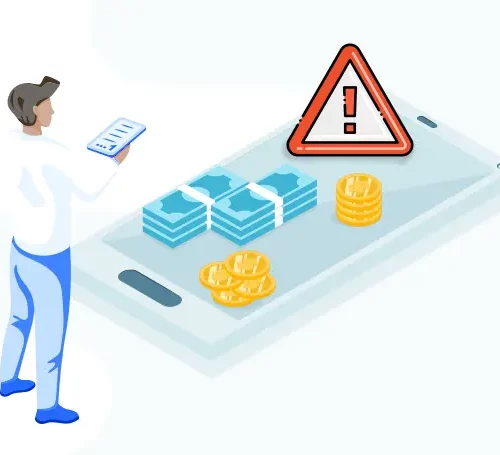12 Factors To Be Considered Before Choosing A Loan Management System



Introduction
Loan processing carried out in quick time provides competitive advantages to NBFCs and MFIs and better utilization of time for the applicants. Hence, there is a pressing need to have a technology that is time-saving for the institutions and convenient for potential borrowers. Many times, the NBFCs have to deal with process delays due to the manual loan processing system, which in some cases, results in losing their prospective customers altogether.
In order to avoid this, most non-banking financial institutions and MFIs are going the way of an automated loan processing system, which in a way, helps both the customers and the institutions. By cutting down on paperwork and manual process needed during the loan application processing period, a loan management system seeks to add immense business value to the MFI and elevate the overall customer experience the applicant receives.
Benefits of a Loan Management System
A well-designed and scalable NBFC Loan Management System aims to improve the quality, turnaround time, and service for end-customers. They ensure that the institutions are better equipped, efficient, and agile.
In other words, they enable financial institutions to automate the processes for achieving cost savings and enhanced customer experience. All types of business activities including trade, industry and agriculture depend on finance in one form or the other. In turn, they directly contribute to better employment opportunities and raise the standard of living of people.
Benefits like optimal work distribution and reduction in overall loan processing time are some of the key benefits that make a loan management system a must-have for a financial organization.
Here are some crucial advantages that a financial institution gets when it opts for an LMS –
1 – Efficiencies of the Cloud
Cloud deployment such as the one provided by a robust LMS will add two layers of benefits
- The operational costs will go down substantially as compared to on-premises deployment
- All matters like installation and upgrades will happen automatically on the cloud. This prevents wastage of time in getting in-house IT support for these tasks and frees up IT resources
2 – Security
2018’s data and privacy issues worldwide have taught us a vital lesson of being vigilant against data breach attempts. With a web-based loan management system, MFIs can enable users with convenient access to credit, without the fear of unauthorized breaches that can harm their financial stability. From the enterprise end too, a secure LMS ensures a streamlined and secured mortgage origination process.
3 – Singular experience
Imagine working on a standalone system which differs in interface or functionality as compared to another device at a different branch of the financial institution? This will lead to a poor user experience from an operational standpoint. With a cloud based loan management system, all users can get a singular and consistent experience irrespective of which device, platform, screen size, or operating systems they access the system from.
If yours is a forward-thinking organization then these benefits will make it clear why a loan management software is absolutely vital to gain a massive edge over your peers in the financial industry
Things To Be Considered Before Choosing Loan Management System
Before opting for a Loan Management System, one needs to consider various aspects so that the desired result can be obtained to the satisfaction of buyers. These factors are of paramount importance in opting for a loan management system.
1. Broader Coverage
It is vital to explore a loan management solution that covers a broad array of uses. Be it mortgage documentation or asset financing, an LMS needs to provide total assistance. It should also deliver performance in financial advancing activities like commercial leasing or consumer loan among other.
A well-structured loan management system would do a great job in these broad areas at a cost-effective price. This adaptability across a wide range of use cases is what will help the LMS software to emerge as a true business value driver for the organization.
2. User Friendly
A complex loan system is hardly appreciated by the customers and rarely do they opt for such financial loans. To improve operational efficiency and boost account management function, you need an LMS that’s simple to setup and configure as per the business’s exclusive needs.
The system should be such that it suits the purpose of the company and is capable of managing its objectives and cater to clients. The model should not only suit the present purposes of the company but should be able to envisage the future needs of the company. It must be capable to handle simple and compound interest rate computation with ease.
From a workflow point of view, the LMS needs to deliver great outcomes. The non-banking financial institutions should get the ability to spend less time on administrative activities. Such user-friendliness in navigation, layout, and processing will add tremendous gains to the company’s ROI from a loan management solution.
3. Centralized Solution
A Loan Management System centralizes loan application data from multiple branches, including links to electronic documents. This ensures that the loan department gets a holistic and singular view of all applications, irrespective of which branch the application has emanated from.
Loans can be conveniently checked against an NBFC’s underwriting protocols. They can also maintain credit compliance details, and allow the processing department to comment, upload the documents, and collaborate with branches and MFI representatives through LMS.
4. Speed & Agility
The quick and streamlined manner of sanctioning of the loan is the most suited discourse for the clients and they are able to appreciate the potential of the non-banking channel in a true sense. In a way, it eliminates the tedious tasks of sorting papers or documents and minimizes the costing involved in the process.
The quick approval and sanction of the loans is an added advantage to obtain financial loans in case of a contingency and in the process save the precious time and nergy of the clients. Such agility in an institution is an asset to the institution and an attraction to the clients.
You may also like: Why Should You Use A Cloud-Based
5. Authenticated Access
Accessibility of loan management system is of utmost importance to the NBFCs for sanctioning of loans. It centralizes all seller data, including links to electronic documents, enabling a robust company review and monitoring process via credential-based access. This helps the financial institutions to access the relevant documents from third-parties quicker and without waiting for unnecessary approvals.
6. Technology and Customer Service Support
The advent of technology is like never before; it is unprecedented and surprising at the same time. All sectors of the civil society are in a consistent endeavor to be abreast with technological advancement. The MFIs should not lag behind in this pursuit and channelize their resources to advance in the technological race. A Loan Management System will help them in this pursuit of obtaining a technological edge.
Post-application processing, the Loan Management System monitors transfer status and enables the transition of the loan to a client’s servicing systems. A good loan management system, therefore, harnesses the technological advancements to provide the best experience of disbursing loans and strengthening the non-banking financial institution’s customer service function.
A fully functional LMS also needs to allow the below functionalities via technology –
- Payment collection to lock successful loan processing
- Contract management and paperwork preparation automation
- Entity management to store all details of loan applicant and servicing branch
- Extensive dashboards and reporting for granular views on KPIs
- Managing information across the board for better collaboration
- Collection and accounting for payments
7. Cloud Based or On-Premises Deployment
Cloud computing is playing a vital role in every sector of business. The same goes for the financial sector. It is in fact, transforming finance with new perspectives, reinventing new models within the financial sector, and developing several new concepts with an aim to improve business efficiencies.
What a cloud computing is enabling is a better management of the lending process in assembling, connecting, and using resources available, to meet business demands and even to provide users with cheaper and secure financial services.
Cloud technology is transforming the lending industry. The potential of the cloud based services are no more unknown and they have become the claimed champions of lower capital outlay, reduced operational costs, quick implementation with frequent software updates, and access to a wide range of data sources. They have benefitted the clients immensely by making the process feasible, more productive, efficient and available at lower costs.
8. Better Third Party Integration
A loan processing module needs to work in sync with a lot of other systems like a CRM or ERP. It also needs to provide the remote sales team with up-to-date information so that the conversion can happen as targeted.
All these require the LMS to connect with third party applications for improved functionality of the overall loan processing function. This feature allows a lot of information to be auto-populated and save time reworking on errors and application submission process.
You may also like: Lending Trends to Watch in 2020
9. Microservices-Based Architecture
Microservices have become the talk of the town today. They have provided the market with software setups that primarily are solo-function modules with well-defined interfaces and operations.
It is also referred to as a Microservice architecture. Therefore, microservices based loan management system would ensure that the system is credible, agile and better suited for the sanctioning of loans.
10. Web And Mobile Compatibility
Application based services in Android and iPhones have become common in today’ mobile driven economy. A mobile-based application can be immensely used in the lending industry.
A number of surveys have over the time made it very clear that clients prefer application based services over the entire labyrinth of complicated procedures.
A loan management system that offers life software support is a testament to the company’s commitment to providing clients with a highly efficient system that will significantly impact your business’s bottom line.
11. 100% Secure Operations
Data protection has become one of the burning issues in the contemporary world as a result of rapid technological advancement. Today, most of the services are just one click away. These services range from retail and healthcare, to banking and insurance services. With this, the emphasis on keeping confidential information secured at all times too has emerged as a value differentiator.
With a cloud based loan system, several features in the form of real time sharing, updating, automatic creation of documents, storage and sharing can be achieved. One can streamline the entire management of loans and all concerned documents through credential-based, secure cloud-based data management.
Security is paramount while opting for the loan management system as you’ll be managing confidential and sometimes critical financial and personal information. Hence, built-in security in your loan management software is crucial.
The system should ensure that the privacy of the clients is not infringed upon. These kinds of circumstances give rise to situations like data fraud leading to loss of credibility and reputation. There has been increased number of instances of imposters acting as employees taking confidential information from innocent people and then taking out money from their accounts. A secure LMS can go a long way in alleviating these problems to a great extent.
12. Scalability Cost
A Loan Management System eliminates the cumbersome work of diligence managers. They need not traverse through various service provider websites. They can also avoid relaying multiple attachments over electronic mail. All findings around the loan processing will be easily stored in the Loan Management System database for instant authenticated access later on.
An LMS should be able to adhere to evolving compliance mechanisms so that there is no non-compliance. Also all costs to scale up the product with growing or more complex operations need to be factored in for getting a true picture of the ROI the product delivers.
To sign off
A wise and practical policy in regard to loans and advances is a crucial factor that instills trust in the depositors of an MFI or NBFC and allows it to augment its topline. These stipulations can be met by a loan management software easily. An efficient loan management system can therefore be an asset and has to be chosen carefully taking into considerations discussed above.
Frequently Asked Questions
What is a Loan Servicing System?
A loan servicing system provides assistance to lenders in managing the administrative tasks associated with a loan, from the moment the loan amount is disbursed until it is fully repaid. These tasks typically include generating monthly payment statements, collecting regular payments, interest calculation, maintaining accurate records of payments and balances, managing delinquent borrowers, and ensuring the loan agreement's terms are enforced, among others.
What kind of software is used for loan processing?
Digital lending software is commonly used for loan processing to assist lenders in managing loan applications, automating loan processing, and streamlining loan origination and management. This type of software offers various features, including document management, credit reporting, underwriting, and borrower management. These features allow lenders to more efficiently manage their loan operations, ultimately resulting in increased efficiency and productivity.
Related Post

How Mobility Is Transforming The Lending Sector
If someone told us a decade ago, how mobility is

Micro Credit – Empowerment and Challenges – A Srilankan Perspective
Rajeshware Srinivasan’s dialogue with Ms. Renuka Rathnahewage, Founding Director and

How To Identify Fraudulent Digital Lending Apps? Types of Lending Frauds and Their Impact
It’s no doubt that Digital Lending Apps have taken the
- Email: [email protected]
- Sales Enquiries: +91 9080996606
- HR Enquiries: +91 9080996576
Quick Links
Resources
© 2025 LightFi India Private Limited. All rights reserved.
(Formerly known as Habile Technologies)
